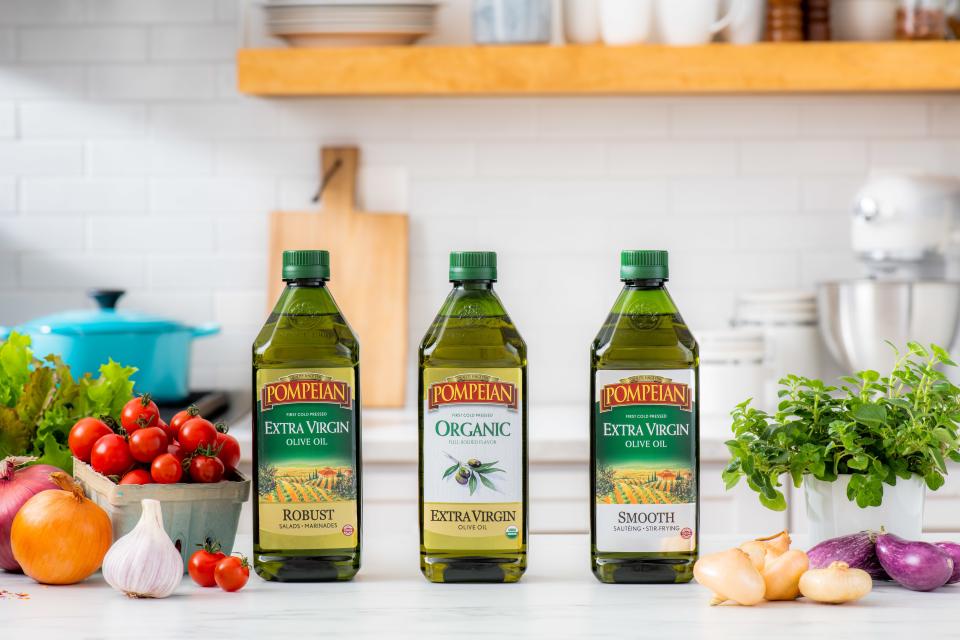3 Things That Make Buying Olive Oil WAY Less Overwhelming
In recent years, the variety and selection offered in grocery stores has expanded exponentially: every shopping trip means selecting from near-infinite options of milk types, different styles of tomatoes, and perhaps the most confusing of them all, an endless wall of olive oil.
While most of us are purchasing and using olive oil for its healthfulness and flavor, the shopping experience can be extremely intimidating and overwhelming, with no way to tell the difference between the flavor. Sometimes we even grab the most affordable bottle for ease and sanity.
But choosing a high-quality, authentic olive oil can be as simple as knowing you prefer oat milk over almond milk, or that you want a sweet heirloom tomato over a tiny cherry one. You might already know that all olive oils are not the same, but understanding the differences between each brand and variety in your olive oil aisle helps you understand the type of oil you’ll be putting in your salad dressing, sautéing your vegetables in, and with which you top your pasta or favorite grain bowl.
Like the other items you add to your grocery cart, understanding the basics of olive oil before you leave the store including, where it came from, how it was made and what signs of quality to look for, will let you walk down the aisle with the confidence that you’re choosing the best bottle to help you eat and live well.

Understand Where It Comes From
The farm-to-table ethos that swept through the food industry over the last decade renewed interest in the people behind our fresh fruits and vegetables. Many often forget: olives are a fruit, too! Similar to the fresh fruit in your produce aisle, the care of the farmers and their love for what they do shows in the finished product—and the flavors in your kitchen. When you know there are passionate, dedicated and experienced people behind the fruit that is grown, you’ll find a better-tasting, higher-quality product.
In practice, that means looking for transparency behind who is growing the olives that go into your olive oil. Look for brands that are willing to show the faces of the people behind the brand, tell the history of the brand, and talk about the hands-on craft of caring for olives from tree to bottle. Look for brands where the farmers are involved in the company, where they have personal stake in creating better olive oil.
One brand to look for is Pompeian, the olive oil people, a family of farmers and master craftsmen whose expertise and dedication help bring the best-tasting, highest-quality olive oils from the grove to your kitchen.

Learn What Indicates High Quality
Olive crops vary from year to year, but like winemaking or coffee, a carefully crafted bottle will always have a product that improves on the flavors of what goes into it. When walking down the olive oil aisle, there are a number of things you should look for on the bottle’s label to make sure you’re grabbing the best olive oil for your shopping cart. Looking for brands that are known for a deep heritage and a strong team of experts is the first step. Check out a brand like Pompeian, which has been around since 1906.— They have master craftsmen all over the world that come together to carefully monitor the olives from branch to bottle, which ensures that they get a consistent, high-quality and authentic olive oil every time. You’ll taste the difference when you add it to your salad dressings, meat marinades or use it for sautéing, grilling, baking, frying or roasting. Another great indicator of quality is certification by third-party experts whether that’s a chef, the North American Olive Oil Association, or looking for a bottle that contains the USDA Quality Monitored Seal.

Pompeian_02_HERO_FAMILY-0308 (1).jpg
Know The Different Varieties of Olive Oil
There are many different kinds of olive oil – from virgin to extra virgin to extra light tasting. Understanding the different varieties of olive oil before your grocery trip will not only make the shopping experience easier but will also allow you to know and experiment with different quality olive oils in your kitchen. “Extra virgin olive oil” means that the oil comes from the first cold pressing of the fruit and that no heat or additives are used. “Extra light tasting olive oil” provides all of the benefits of cooking with olive oil, but with a lighter flavor — where it’s equally important to ensure there are dedicated and passionate craftsmen behind your bottle. While extra virgin olive oil is preferred by many for flavor, there are quality options in all varieties of olive oil depending on your taste preference.
Doing just a little research goes a long way when it comes to shopping for olive oil— and the results on the plate— so make sure to read the labels and go online prior to your grocery trip to learn about the history behind the bottle, who is making your olive oil, and to know if they’re committed to quality. Equipped with these few simple reminders will make choosing the best brand of olive oil easy.
Originally Appeared on Epicurious

